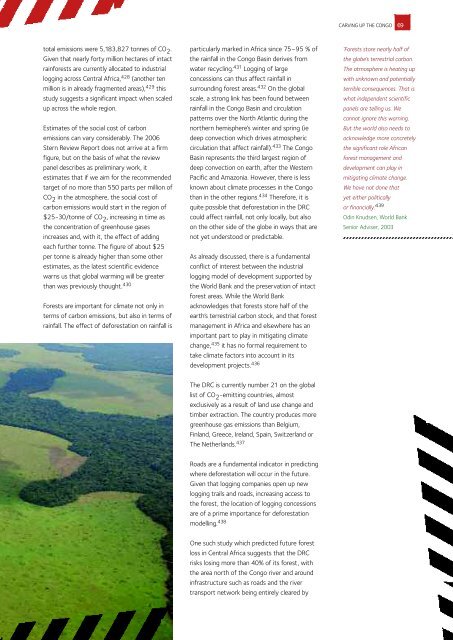Untitled - Greenpeace
Untitled - Greenpeace
Untitled - Greenpeace
You also want an ePaper? Increase the reach of your titles
YUMPU automatically turns print PDFs into web optimized ePapers that Google loves.
CARVING UP THE CONGO 69<br />
total emissions were 5,183,827 tonnes of CO 2 .<br />
Given that nearly forty million hectares of intact<br />
rainforests are currently allocated to industrial<br />
logging across Central Africa, 428 (another ten<br />
million is in already fragmented areas), 429 this<br />
study suggests a significant impact when scaled<br />
up across the whole region.<br />
Estimates of the social cost of carbon<br />
emissions can vary considerably. The 2006<br />
Stern Review Report does not arrive at a firm<br />
figure, but on the basis of what the review<br />
panel describes as preliminary work, it<br />
estimates that if we aim for the recommended<br />
target of no more than 550 parts per million of<br />
CO 2 in the atmosphere, the social cost of<br />
carbon emissions would start in the region of<br />
$25-30/tonne of CO 2 , increasing in time as<br />
the concentration of greenhouse gases<br />
increases and, with it, the effect of adding<br />
each further tonne. The figure of about $25<br />
per tonne is already higher than some other<br />
estimates, as the latest scientific evidence<br />
warns us that global warming will be greater<br />
than was previously thought. 430<br />
Forests are important for climate not only in<br />
terms of carbon emissions, but also in terms of<br />
rainfall. The effect of deforestation on rainfall is<br />
particularly marked in Africa since 75–95 % of<br />
the rainfall in the Congo Basin derives from<br />
water recycling. 431 Logging of large<br />
concessions can thus affect rainfall in<br />
surrounding forest areas. 432 On the global<br />
scale, a strong link has been found between<br />
rainfall in the Congo Basin and circulation<br />
patterns over the North Atlantic during the<br />
northern hemisphere’s winter and spring (ie<br />
deep convection which drives atmospheric<br />
circulation that affect rainfall). 433 The Congo<br />
Basin represents the third largest region of<br />
deep convection on earth, after the Western<br />
Pacific and Amazonia. However, there is less<br />
known about climate processes in the Congo<br />
than in the other regions. 434 Therefore, it is<br />
quite possible that deforestation in the DRC<br />
could affect rainfall, not only locally, but also<br />
on the other side of the globe in ways that are<br />
not yet understood or predictable.<br />
As already discussed, there is a fundamental<br />
conflict of interest between the industrial<br />
logging model of development supported by<br />
the World Bank and the preservation of intact<br />
forest areas. While the World Bank<br />
acknowledges that forests store half of the<br />
earth’s terrestrial carbon stock, and that forest<br />
management in Africa and elsewhere has an<br />
important part to play in mitigating climate<br />
change, 435 it has no formal requirement to<br />
take climate factors into account in its<br />
development projects. 436<br />
‘Forests store nearly half of<br />
the globe’s terrestrial carbon.<br />
The atmosphere is heating up<br />
with unknown and potentially<br />
terrible consequences. That is<br />
what independent scientific<br />
panels are telling us. We<br />
cannot ignore this warning.<br />
But the world also needs to<br />
acknowledge more concretely<br />
the significant role African<br />
forest management and<br />
development can play in<br />
mitigating climate change.<br />
We have not done that<br />
yet either politically<br />
or financially.’ 439<br />
Odin Knudsen, World Bank<br />
Senior Adviser, 2003<br />
The DRC is currently number 21 on the global<br />
list of CO 2 -emitting countries, almost<br />
exclusively as a result of land use change and<br />
timber extraction. The country produces more<br />
greenhouse gas emissions than Belgium,<br />
Finland, Greece, Ireland, Spain, Switzerland or<br />
The Netherlands. 437<br />
Roads are a fundamental indicator in predicting<br />
where deforestation will occur in the future.<br />
Given that logging companies open up new<br />
logging trails and roads, increasing access to<br />
the forest, the location of logging concessions<br />
are of a prime importance for deforestation<br />
modelling. 438<br />
One such study which predicted future forest<br />
loss in Central Africa suggests that the DRC<br />
risks losing more than 40% of its forest, with<br />
the area north of the Congo river and around<br />
infrastructure such as roads and the river<br />
transport network being entirely cleared by

















